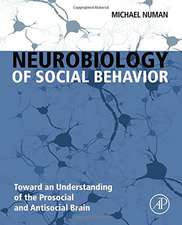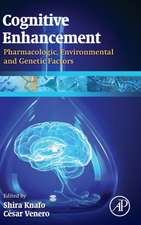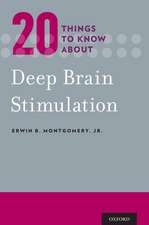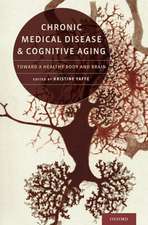Higher Cortical Functions in Man
Traducere de Basil Haigh Autor Alexandr Romanovich Luriaen Limba Engleză Paperback – 11 feb 2012
Preț: 899.05 lei
Preț vechi: 946.37 lei
-5% Nou
Puncte Express: 1349
Preț estimativ în valută:
172.05€ • 178.61$ • 143.46£
172.05€ • 178.61$ • 143.46£
Carte disponibilă
Livrare economică 04-18 martie
Livrare express 15-21 februarie pentru 53.02 lei
Preluare comenzi: 021 569.72.76
Specificații
ISBN-13: 9781461585817
ISBN-10: 1461585813
Pagini: 660
Ilustrații: 656 p.
Dimensiuni: 155 x 235 x 35 mm
Greutate: 0.91 kg
Ediția:2nd ed. 1980. Softcover reprint of the original 2nd ed. 1980
Editura: Springer Us
Colecția Springer
Locul publicării:New York, NY, United States
ISBN-10: 1461585813
Pagini: 660
Ilustrații: 656 p.
Dimensiuni: 155 x 235 x 35 mm
Greutate: 0.91 kg
Ediția:2nd ed. 1980. Softcover reprint of the original 2nd ed. 1980
Editura: Springer Us
Colecția Springer
Locul publicării:New York, NY, United States
Public țintă
ResearchDescriere
This full-length translation of Professor Luria's book introduces to the English speaking world a major document in neuropsychology, summarizing Professor Luria's earlier contributions to that area for nearly a third of a century. It is a monumental contribution. Nothing of this scope exists in the Western literature of this field, with the possible exception of Ajuriaguerra and Hecaen's book (in French) on the cerebral cortex. Professor Luria's book thus marks a further and decisive step toward the eventual coalescence of neurology and psychology, a goal to which only a few laboratories in the East and West have been devoted over the last decades. The book is unique in its organization. The first half deals with observations and interpretations concerning the major syndromes of man's left cerebral hemisphere: those grievous distortions of higher functions traditionally described as aphasia, agnosia, and apraxia. There is also a detailed and brilliant analysis of the syndrome of massive frontal-lobe involvement. The entire second half of the book is given over to a painstaking description of Professor Luria's tests, many of them introduced by himself, and set out in such detail that anyone could repeat them and thus verify Professor Luria's interpretations.
Cuprins
I The Higher Mental Functions and Their Organization in the Brain.- 1. The Problem of Localization of Functions in the Cerebral Cortex.- A. Psychomorphological Concepts and Their Crisis—A Historical Survey.- B. Re-examination of the Concept of Function and of the Principles of Its Localization.- C. The Higher Mental Functions in Man.- 2. Modern Data on the Structural Organization of the Cerebral Cortex.- A. Original Conceptions.- B. Structural Organization of the Posterior Cortical Divisions.- C. Structural Organization of the Anterior Cortical Divisions.- D. Progressive Differentiation of the Cortical Regions and Fields in the Course of Phylogenesis and Ontogenesis.- E. Structural Organization and Connections of the Mediobasal Cortical Divisions.- F. Functional Properties of Cortical Neurons.- 3. Disturbances of Higher Mental Functions in the Presence of Local Brain Lesions.- II Disturbances of the Higher Cortical Functions in the Presence of Local Brain Lesions.- 1. Some Functional Investigative Problems.- A. Principal Forms of Disturbance of the Higher Cortical Functions Resulting from Local Brain Lesions.- B. The Problem of the Dominant Hemisphere.- C. General Cerebral Components in Cases of Local Brain Lesions.- 2. Disturbances of Higher Cortical Functions with Lesions of the Temporal Region.- A. Historical Survey.- B. The Auditory Analyzer and the Structure of the Auditory Cortex.- C. Language Sounds and the Hearing of Speech.- D. Disturbances of Higher Cortical Functions with Lesions of the Cortical Nucleus of the Auditory Analyzer. Acoustic Agnosia and Sensory Aphasia.- E. Disturbances of Higher Cortical Functions with Lesions of the Middle Segments of the Temporal Region. Acoustic-Mnestic Aphasia.- F. Disturbances of Intellectual Processes with Temporal Lesions.- G. Disturbances of Psychological Processes in Lesions of the Medial Zones of the Temporal Regions.- 3. Disturbances of Higher Cortical Functions with Lesions of the Occipital and Occipitoparietal Regions.- A. Historical Survey.- B. The Visual Analyzer and the Structure of the Visual Cortex.- C. Disturbed Object Perception with Lesions of the Visual Cortex and Concurrent Agnosia.- D. Disturbed Tactile Perception and Tactile Agnosia.- E. Spatial Disorientation and Constructive Apractagnosia.- F. Disturbed Logical-Grammatical Operations and Semantic Aphasia.- G. Disturbances of Arithmetical Operations and the Syndrome of Acalculia.- H. Disturbances of Intellectual Processes.- 4. Disturbances of Higher Cortical Functions with Lesions of the Sensorimotor Regions.- A. Historical Survey.- B. The Motor Analyzer and the Structure of the Sensorimotor Region.- C. Disturbances of the Afferent Basis of Voluntary Movement. Afferent (Kinesthetic) Apraxia.- D. Disturbances of the Kinesthetic Basis of Speech. Afferent (Kinesthetic) Motor Aphasia.- E. Disturbances of Motor Functions with Lesions of the Pre-motor Region.- F. Disturbances of the Kinetic Structure of Speech. Efferent (Kinetic) Motor Aphasia.- G. Frontal “Dynamic” Aphasia.- H. Disturbances of Intellectual Processes with Lesions of the Premotor Region.- 5. Disturbances of Higher Cortical Functions with Lesions of the Frontal Region.- A. Historical Survey.- B. Structure and Functions.- C. The Frontal Lobes and Regulation of States of Activity.- D. The Frontal Lobes and Regulation of Movements and Actions.- E. Gnostic Disturbances.- F. Mnestic Disturbances.- G. Intellectual Disturbances.- H. Principal Variants of the Frontal Syndrome.- 6. Disturbances of Higher Cortical Functions in Deep Brain Lesions.- 7. On Function Interaction Between the Hemispheres.- III Methods of Investigating the Higher Cortical Functions in Local Brain Lesions (Syndrome Analysis).- 1. Objectives of Neuropsychological Investigation of Higher Cortical Functions in the Presence of Local Brain Lesions.- 2. The Preliminary Conversation.- 3. Investigation of Motor Functions.- A. Preliminary Remarks.- B. Investigation of the Motor Functions of the Hands.- C. Investigation of Oral Praxis.- D. Investigation of Complex Forms of Organization of Movements and Actions.- 4 Investigation of Acoustico-Motor Coordination.- A. Preliminary Remarks.- B. Investigation of the Perception and the Reproduction of Pitch Relationships.- C. Investigation of the Perception and the Reproduction of Rhythmic Structures.- 5. Investigation of the Higher Cutaneous and Kinesthetic Functions.- A. Preliminary Remarks.- B. Investigation of Tactile (Cutaneous) Sensation.- C. Investigation of Deep (Kinesthetic) Sensation.- D. Investigation of the Higher Tactile Functions and Stereognosis.- 6. Investigation of the Higher Visual Functions.- A. Preliminary Remarks.- B. Investigation of the Visual Perception of Objects and Pictures.- C. Investigation of Spatial Orientation.- D. Investigation of Intellectual Operations in Space.- 7. Investigation of Mnestic Processes.- A. Preliminary Remarks.- B. Investigation of the Direct Impression of Traces.- C. Investigation of the Learning Process.- D. The Role of Interference in Disturbances of Mnestic Processes.- E. Investigation of Logical Memorizing.- 8. Investigation of Speech Functions. Receptive Speech.- A. Preliminary Remarks.- B. Investigation of Phonemic Hearing.- C. Investigation of Word Comprehension.- D. Investigation of the Understanding of Simple Sentences.- E. Investigation of the Understanding of Logical-Grammatical Structures.- 9. Investigation of Speech Functions. Expressive Speech.- A. Preliminary Remarks.- B. Investigation of the Articulation of Speech Sounds.- C. Investigation of Reflected (Repetitive) Speech.- D. Investigation of the Nominative Function of Speech.- E. Investigation of Narrative Speech.- 10. Investigation of Writing and Reading.- A. Preliminary Remarks.- B. Investigation of the Phonetic Analysis and Synthesis of Words.- C. Investigation of Writing.- D. Investigation of Reading.- 11. Investigation of Arithmetical Skill.- A. Preliminary Remarks.- B. Investigation of the Comprehension of Number Structure.- C. Investigation of Arithmetical Operations.- 12. Investigation of Intellectual Processes.- A. Preliminary Remarks.- B. Investigation of the Understanding of Thematic Pictures and Texts.- C. Investigation of Concept Formation.- D. Investigation of Discursive Intellectual Activity.- Conclusion.- Russian.- Non-Russian.- Author Index.












